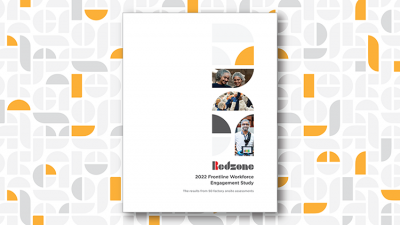Promotional Features
New Redzone Study Shows Significant Improvement in Factory Performance
The 2022 Frontline Workforce Engagement Study is the first of its kind to shed light on the relationship between employee engagement, productivity increases, and employee retention.
Since its inception in 2013, Redzone has helped food, beverage, and CPG manufacturers gain double-digit gross margins increases, with most breaking their own production records.
Inspired by anecdotal stories of culture improvements and frontline engagement from more than 850 plants that make up its community, Redzone conducted a study to quantify the improvements in productivity, employee retention, and five critical areas of employee engagement. As a result, Redzone recently published its first biennial study on frontline workforce engagement utilizing the Redzone Connected Workforce Solution.
Society’s realization that frontline workers are essential to the economy was also an inspiration to create and launch the study. “Employees don’t just want to clock in and out,” reports Ken Fisher, Redzone Vice President of Product Management and Solutions Consulting. “They want to compete, win and be treated with dignity as a valuable team member.”
According to data from The Manufacturing Institute, the top three reasons why employees remain loyal to their workplace are enjoyment of the work (83%), stability and job security (79%), and the company’s family-oriented/team culture (69%). Pay? That ranked a lowly 14th (43%).
The research encompassed on-site assessments (surveys, interviews, and on-site audits) in 50 plants deploying the Redzone Connected Workforce Solution. The design of the study includes assessing five areas of engagement, which were assessed at baseline and after the 90 days.
1. Ownership of Performance
Prior to deployment, frontline employees tended to be somewhat unaware or unsure of their goals and their actual performance. “Winning” was frequently equated with “not messing up.” Performance problems were blamed on outside elements (e.g., machines, material, management, or other departments). Further, frontline employees were unaware of their participation in the goals of their shifts.
“Productivity improvements in factories with this culture tend to be stagnant or, at best, grow 2-3% annually,” Fisher remarks. “This is likely because most improvements are made by managers and engineers, who represent a small number of overall factory employees."
After the 90 days of deployment, there were significant changes in the ways employees participate in improving line performance and winning the day. For example, “winning” was now more commonly associated with “exceeding targets for safety, quality, and productivity.” When a problem occurred, more employees took ownership when appropriate, instead of blaming other forces. “When frontline employees are encouraged to take ownership of their production areas, plant productivity improves,” Fisher comments.
2. Autonomous Problem Solving
Conventionally, when issues arise, plants tend to rely upon supervisors to engage in root-cause analysis; rarely do frontline workers proactively weigh in. Even in plants with mature continuous improvement programs, the frontline teams typically perform root cause analysis only when directed or prompting a predefined trigger (e.g., two hours of unplanned downtime requires a 5-why). Even worse, the common corrective action presented after analysis is the administrative directive to “retrain the employee.”
After deploying the Redzone Connected Workforce Solution, analyses showed that teams are conducting root cause problem-solving activities more proactively. Simple root-cause analyses are conducted routinely for repetitive problems that tend to occur during the shift. Lastly, the improvement actions created by these activities focus on solving the problem forever by eliminating, substituting, or engineering out the root cause to prevent reoccurrence.
The results show a 50% increase in autonomous problem solving, showing that many more frontline employees are actively engaged in solving simple and complex problems that arise during the shift.
3. Connection to Other People and Teams
“Engagement” by its nature encompasses communication with others, fostering and sustaining teamwork. It is also characterized by ease, quantity, and quality of real-time communication in the plant.
Without deploying a connected workforce solution, a typical factory will operate largely using “the telephone game,” wherein a problem is communicated to the observer’s supervisor, who relates it to the problem solver’s boss, who describes it to the problem solver. This chain of activity has several problems: time to resolve the issue is lengthy, and the details are lost in translation or miscommunicated both ways, resulting in increased inefficiencies, slow resolution, and frustrated employees.
Factories using the Redzone Connected Workforce Solution showed more frontline employees engaged in constant communication about plans, problems, and priorities regardless of their position in the organization’s hierarchy. “Operators talk directly to technicians, technicians speak directly to operations supervisors, etc.,” Fisher explains. “This occurs because physical, language and organizational barriers are digitally eliminated. The results showed that these plants experienced a 71% increase in communication and connectedness.”
4. Cross-team Collaboration
There is a distinction between communication and collaboration: communication is the unstructured exchange of ideas and discussion of issues and their resolutions; collaboration is engaging in formal workflows with other departments to solve a problem or achieve a common goal.
Plants that have high levels of cross-team collaboration have frontline employees who exhibit four common behaviors: they engage in multiple shop floor huddles per shift, they take part in daily production meetings that are interlocked with shop floor huddles, they participate in regular cross-functional Kaizens, and there is evenly distributed action ownership with refined action cycles.
The cross-team collaboration component saw the second highest increase at 81% above the baseline level. And it tends to feed upon itself. Fisher explains, “The hidden but potentially largest benefit of these behaviors is that a virtuous cycle is created when teams solve problems together: the team solves a problem, the team builds trust and camaraderie through the shared experience, the team wants to solve more problems, the team gets better at solving problems, repeat.”
5. Feeling Competent and Recognized
Universally, at any level, people want to feel that their work is noticed and appreciated, and that when they perform very well, they receive recognition. This will sustain their desire to continue to perform at a high level.
Therefore, the final component of engagement in the study assessed how much frontline employees feel competent and recognized at work. “Improving this component is likely the largest contributor to the increase in retention that high performing plants experience,” emphasized Fisher.
The study reviewed the four parts of the employee lifecycle – onboarding, on-the-job training, knowledge sharing, and career progression. Prior to deploying the Redzone Connected Workforce Solution, the typical route taken by new hires included watching a quick safety orientation video then shadowing a veteran employee. The baseline assessment also showed that many employees lacked clear, direct instructions and were hesitant to ask questions, resulting in mistakes. The problem tends to continue with a lack visibility into a career-path so, employees disengage and/or quit.
The employee experience changed dramatically after deploying the Redzone Connected Workforce Solution. “Their skills and performance were noticed by peers and plant leadership alike; so, employees received regular recognition and ultimately achieve new skills or promotions,” Fisher relates.
Overall Results
The study concluded with all 50 plants exhibiting a positive change in engagement. The overall increase in engagement scores was 74%, with plants ranging from +47% to +170%. The engagement characteristic that demonstrated the most significant change was ownership of performance which increased by 112%, with scores ranging from 25% to 200%.
Additionally, the 50 factories in the study experienced a 32% reduction in employee turnover while simultaneously, the broader manufacturing industry saw turnover worsen by 50%.
Plants in the study had a baseline overall equipment effectiveness (OEE) of 50% and after 90 days, increased to 62.8%. This increase in OEE equals a 26% increase in productivity (e.g. cases produced per hour). Each plant in the study showed a positive increase in OEE. These results are similar to the broader Redzone community’s productivity increase from the most recent benchmark report which saw an average 22% productivity uplift across 700 plants.
Fisher concludes, “What is clearly established in our 2022 Frontline Workforce Engagement Study is that all 50 plants experienced increases in productivity, engagement, and retention over time – creating a virtuous cycle that strengthens with each full revolution.”
Download your complimentary copy of the Redzone 2022 Frontline Workforce Engagement Study.




